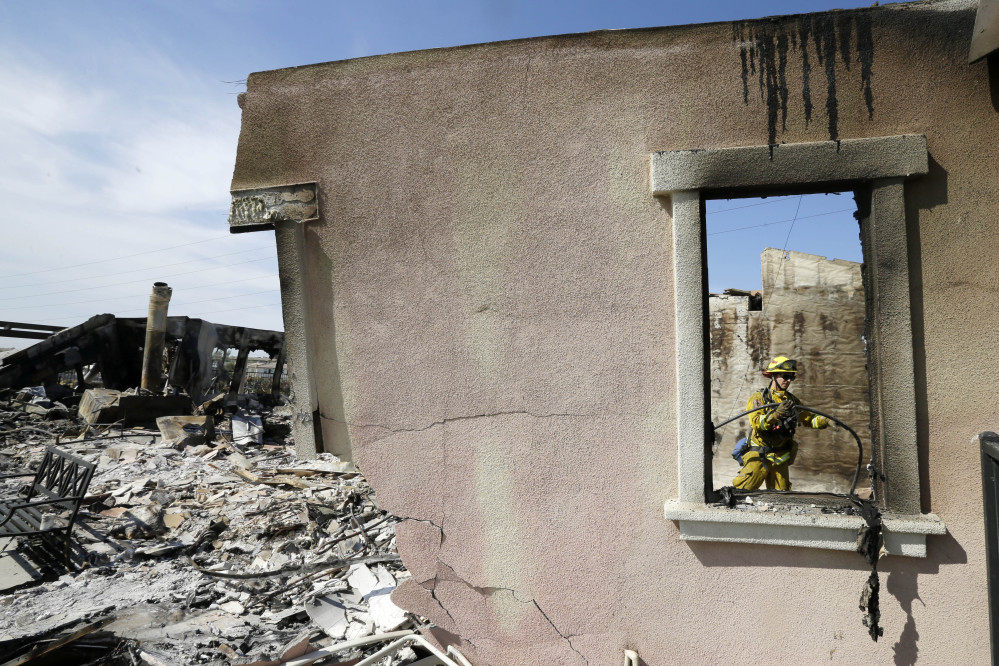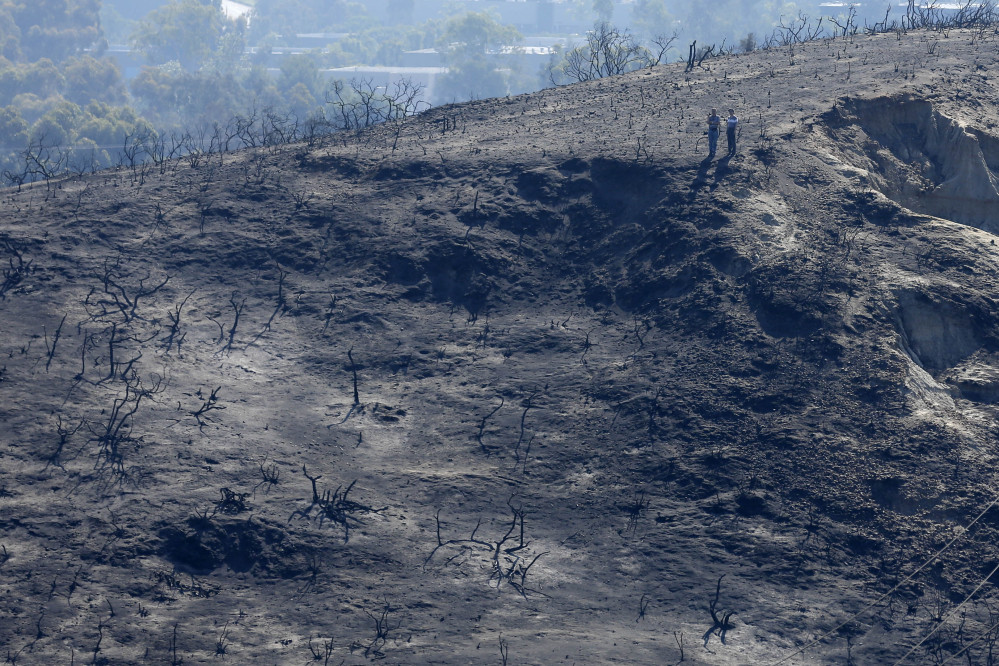SAN DIEGO – A state fire official says a spark from construction equipment ignited the first of 10 major fires that have burned in San Diego County this week.
California Department of Forestry and Fire Protection spokeswoman Lynne Tolmachoff said Friday that investigators believe the blaze that charred more than 1,500 acres in the Rancho Bernardo suburb was accidental.
She said causes of the other fires have not been determined. Officials are looking into everything from car sparks to arson as possibilities.
The Rancho Bernardo fire started Tuesday and was largely under control by Wednesday when eight more fires erupted.
Some evacuation orders were lifted early Friday in an area near the fiercest of several wildfires still burning, as crews building containment lines around the blazes hoped cooler temperatures will help them make further progress.
County officials said residents of two neighborhoods of San Marcos were allowed to return home. A flare-up Thursday in the north San Diego suburb prompted more than 18,000 new evacuation notices as flames raced through tinder-dry brush on hillsides. That fire was 10 percent contained Friday morning.
Ten major fires have destroyed at least eight houses, an 18-unit condominium complex and two businesses since Tuesday. The hardest-hit areas were in San Marcos and Carlsbad, a suburb of 110,000 people that lifted evacuation orders late Thursday.
Firefighters found a badly burned body Thursday in a transient camp in Carlsbad – the first apparent fatality – and a Camp Pendleton Fire Department firefighter was treated for heat exhaustion.
To the north crews battled two fires at Camp Pendleton, including one that broke out Thursday and grew overnight from 600 acres to 8,000, base officials told KGTV. It was 10 percent contained. The second fire, sparked Wednesday on the eastern outskirts of the Marine base, scorched nearly 10 square miles of dry brush. That blaze was 15 percent contained.
This week’s unseasonably early wildfires have driven tens of thousands from their homes and shut down schools and amusement parks, including Legoland, which reopened Thursday. Flames have caused more than $20 million in damage.
In Escondido, just southeast of San Marcos, Al Said stood in front of his spared home on Friday and pointed out two burned neighboring houses. He chose not to evacuate and used a garden hose to help firefighters save his home.
“By the grace of God and the hard work of these firefighters, they came in and they saved my house right here,” he told The Associated Press. “It was pretty touch-and-go. Just an awesome sight when you see that fire come through. It’s just terrifying.”
Firefighters who have worked in temperatures sometimes topping 100 degrees this week were expected to get relief on Friday. The forecast called for temperatures to peak around 90 and lighter winds. A bigger cool-down was forecast for the weekend.
It could take months to find the causes of the blazes concentrated in the northern San Diego and its northern suburbs, from the coast to areas 10 to 15 miles inland. San Diego County Sheriff Bill Gore said arson will be among the many possibilities that investigators will look at.
Police in Escondido, a city north of San Diego, arrested a teen and adult for investigation of arson in two small fires that were extinguished within minutes in a park area near a mall. Lt. Neal Griffin said Friday authorities are not ruling out anything yet but have found no evidence linking the two to the 10 large blazes.
Crews along with engines and aircraft were ready to spring into action when the first fire ignited Tuesday after being sent to the region in anticipation of a heat wave and gusty winds.
The positioning of crews was among several steps fire officials say they have been fine-tuning since 2003 when the San Diego area experienced one of the worst infernos in California’s history. Communications between firefighting agencies has improved, residents are notified more quickly when to evacuate, and more aircraft are available to dump water on fast-moving flames.
San Diego County had some of the strongest Santa Ana winds Wednesday, with gusts reaching up to 50 mph, which may have set conditions for fires to be easily ignited, just as they were in 2003. The 2003 Cedar Fire scorched more than 437 square miles, nearly 3,000 buildings – including more than 2,000 homes – and killed 15 people before being contained.
The tragedy led to California creating one of the world’s most robust firefighting efforts, which resulted in the smooth evacuation of thousands this week and crews able to save hundreds of homes from being consumed by the fast-moving wildfires, said Battalion Chief Nick Schuler of the California Department of Forestry and Fire Protection.
Before another devastating wave of fires swept the San Diego region in 2007, the city and county introduced a system of automated calls to homes and businesses. Previously, evacuations were accomplished by going door to door or driving down the streets with loudspeakers.
Upgrades at dispatch centers have allowed firefighting agencies to share resources far more quickly by computer, a contrast to 2003 when agencies had to pick up the phone to move engines around, said David Allen, division chief for the state firefighting agency.
There is also a stronger relationship between the state firefighting agency and the military, which had 22 aircraft fighting the fires Thursday.
Those procedures are expected to be tested further as drought-plagued California heads into the summer months of what is expected to be one of its busiest firefighting seasons yet.
Send questions/comments to the editors.




Success. Please wait for the page to reload. If the page does not reload within 5 seconds, please refresh the page.
Enter your email and password to access comments.
Hi, to comment on stories you must . This profile is in addition to your subscription and website login.
Already have a commenting profile? .
Invalid username/password.
Please check your email to confirm and complete your registration.
Only subscribers are eligible to post comments. Please subscribe or login first for digital access. Here’s why.
Use the form below to reset your password. When you've submitted your account email, we will send an email with a reset code.